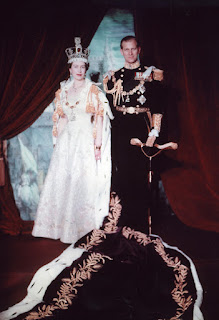The beautiful princess at Queen Juliana's coronation in 1947 Fotograaf Onbekend / Anefo, CC0, via Wikimedia Commons
Princess Margaret once said that she would curse Tommy
Lascelles, the Queen’s Private Secretary, until the day she died. She largely
blamed the indefatigable courtier for preventing her marriage to the handsome
Group Captain Peter Townsend, arguably the love of her life. This doomed
romance she later said had ‘ruined her life’. Would she have been happy with
the tall, good-looking Group Captain? Her being prevented from
marrying him unless she gave up her royal rights and privileges certainly seems almost
unimaginable today (at least in the UK), and extremely unfair.
The romance began when Princess Margaret was very young. In
one account, a woman who worked at Queen Adelaide’s Cottage where Peter
Townsend and his family lived when he was equerry to King George VI used to
watch Princess Margaret visit the family. This woman thought that the Princess
had a ‘crush’ on Townsend, and that she wasn’t there to see his wife and two sons!
The very attractive Princess used to persuade Peter to go riding with her. Once she was 17, she used
to leave the top buttons of her blouse undone, and Townsend must have found
thoughts of a relationship hard to resist!
The Princess became even closer to him on the family’s South
African tour in 1947, walking and riding with him in the stunning countryside.
No wonder Townsend’s marriage began to show signs of strain when he came back! She also insisted that he accompany her to Queen Juliana’s coronation in
Holland in the same year, where people noticed the attraction between them.
After Townsend became Deputy Master of the Household, Princess Margaret was
only one floor above him, so they could easily meet and talk. (There is a
touching scene in “The Crown” in which she rushes down to kiss him, wearing the
most gorgeous dress). As the romance grew stronger, they even built cairns of
stones in the countryside near Balmoral to celebrate their rides together,
taking a leaf from Queen Victoria who did this to commemorate happy occasions).
Soon Townsend was granted a divorce from his wife, who
married John de Lazlo (the son of the famous artist) two months later. Princess
Margaret and Townsend discussed marriage as they rode together, or walked under
the oaks and beeches of the Great Park at Windsor Castle. When Lascelles heard
of this, he was furious, telling the Group Captain that: ‘You must be either
mad or bad’. However, he also told the couple that the marriage was possible,
but vowed secretly to do everything that he could to prevent it. He advised the
Queen that Townsend should be sent abroad immediately.
The affair remained secret until the Princess brushed fluff
off Townsend’s uniform at the Queen’s coronation in 1953. After this, gossip reached
breaking point. Tommy Lascelles and Winston Churchill were both strongly
against the match, and Winston Churchill told the Queen that Parliament would
probably not approve the match. (Princess Margaret needed the approval of
Parliament and the Dominions to marry the Group Captain because of his divorce,
and because she was under 25). The couple agreed to postpone the engagement,
and for Townsend to go away. The Princess thought that she would see him again
after her tour, however, but he was sent to the British Embassy in Brussels for
two years, while she was away! She must have been furious.
According to Noel Botham, however, Townsend saw her secretly
at romantic weekends at friend’s country houses on visits to England during
these years. Nobody told the Princess, however, that it was unlikely that
Parliament would approve the match even after she was 25 – she later said that
if she had known the position of the Church and that she would have to give up
her royal advantages if they married, they would have ended the romance near
the start.
When the Princess turned 25 in 1955, she and Townsend were
horrified to discover the attitude of the PM (Sir Anthony Eden, who was
divorced himself), Parliament and the Church. At a meeting with the Queen and
Prince Philip, Margaret was told by the PM that her only option if she wanted
to marry Townsend was to give up her right of succession and her Civil List
income. This would require Parliament to pass a special bill, and he thought
that it would cause ‘irreparable damage to the crown’. Also, any children the
couple had would be regarded as illegitimate by the Church of England. Margaret
did not realise this. As Princess Margaret was very religious, this may have
been the deciding factor against the marriage.
A leader in The Times, stated that the Royal family
should present a model of an ideal family life, and if the Princess married
Townsend, this would become ‘distorted’, and that many of the Queen’s subjects
would not ‘in conscience regard as a marriage’. Faced with such pressure,
Margaret and her tall, handsome Group Captain decided against the match. He
later wrote that they may not have enjoyed a happy marriage. She would have
‘had to give up everything –her position, her prestige, her privy purse.’ He
didn’t think that he had ‘the weight…to counter-balance all she would have lost’.
He also wouldn’t have wanted her ‘to become an ordinary housewife’.
However, if she had not had to give up everything, and if
she had been allowed to marry Townsend, perhaps they would have been happy. Unfortunately,
fate had other plans for the popular, attractive and lively Princess.

.jpg)






